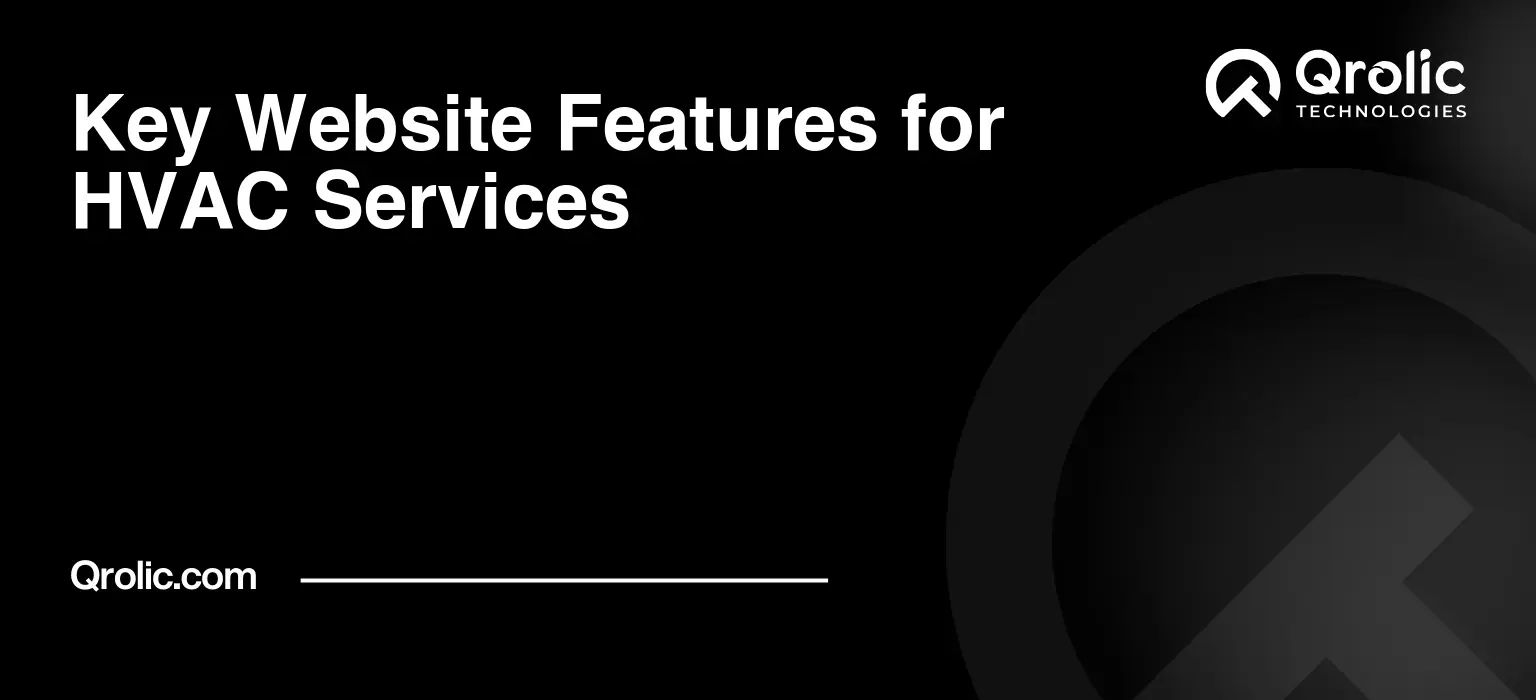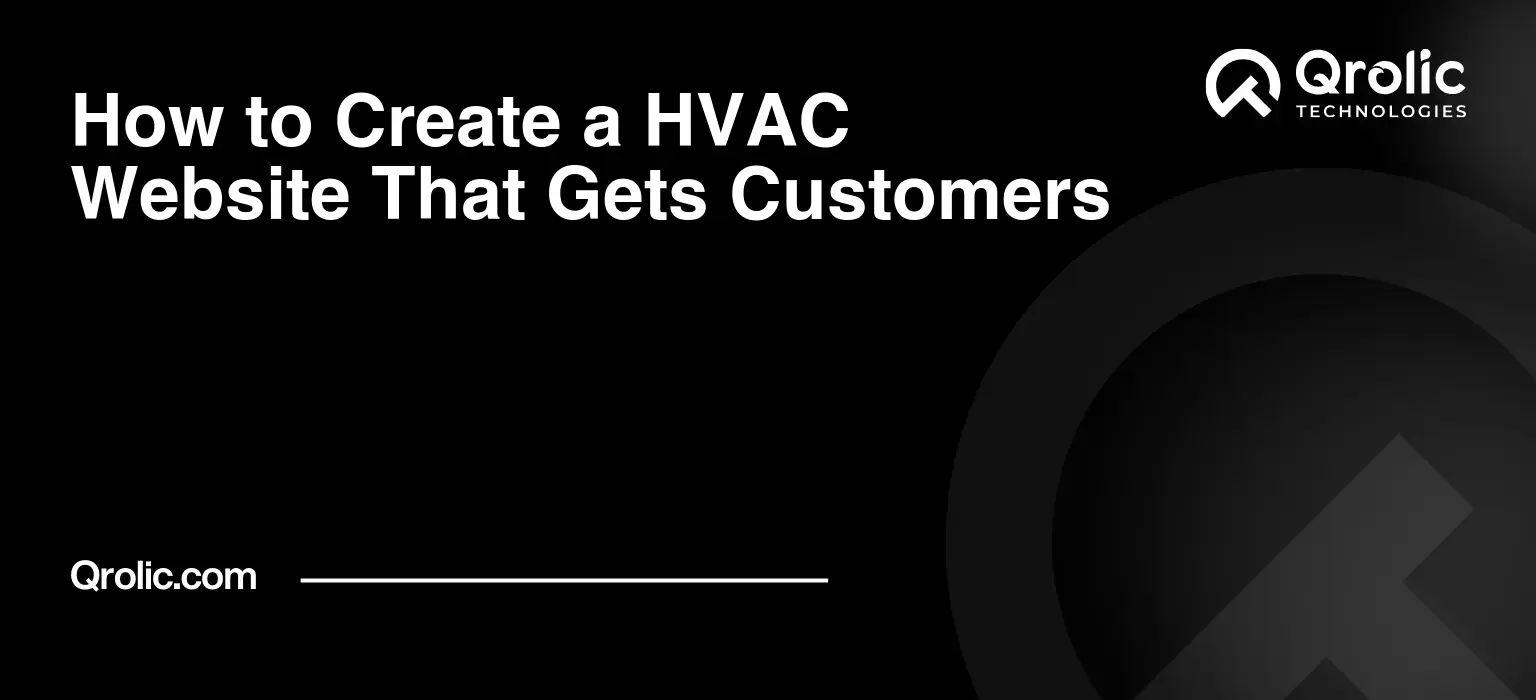Quick Summary:
- Your HVAC website is a 24/7 lead generator.
- Offer clear services, easy contact, and customer trust.
- Create engaging content like blogs and FAQs.
- Ensure fast loading and mobile-friendly design.
Table of Contents
- Why Your HVAC Business Needs a Stellar Website
- Understanding the Core Needs of HVAC Website Visitors
- Essential HVAC Website Features: The Foundation for Success
- 1. A Clean, Professional, and Mobile-Responsive Design
- 2. Clearly Defined HVAC Services Pages
- 3. Online Service Request Form: Make it Easy to Connect
- 4. Online Maintenance Scheduling System
- 5. Customer Testimonials and Reviews: Building Trust
- 6. Before & After Photos: Showcasing Your Work
- 7. Informative Blog Content: Establishing Expertise and Improving SEO
- 8. FAQ Section: Addressing Common Concerns
- 9. Pricing Information (Where Appropriate): Transparency Builds Trust
- 10. Geolocation and Service Area Information
- 11. Live Chat: Instant Customer Support
- 12. Emergency Service Information: Addressing Urgent Needs
- 13. Energy Efficiency and Rebate Information: Appealing to Eco-Conscious Customers
- 14. Secure Socket Layer (SSL) Certificate: Protecting Customer Data
- 15. Fast Page Load Speed: A Crucial Ranking Factor
- Beyond the Basics: Advanced HVAC Website Features
- Qrolic Technologies: Your Partner in HVAC Website Success
- Measuring and Analyzing Website Performance
- Continuous Improvement: The Key to Long-Term Success
- Conclusion: Investing in Your Online Future
Why Your HVAC Business Needs a Stellar Website

In today’s digital landscape, a robust online presence is no longer optional for HVAC businesses; it’s a necessity. Think of your website as your 24/7 storefront, a tireless employee working to attract new customers and solidify relationships with existing ones. But simply having a website isn’t enough. It needs to be optimized, user-friendly, and packed with features that cater specifically to the needs of your target audience. Ignoring this is like leaving money on the table – allowing competitors to snatch up potential clients who are actively searching for HVAC solutions. This is where understanding and implementing the key website features becomes paramount. Without a compelling website, you risk losing valuable leads and falling behind in a competitive market.
Understanding the Core Needs of HVAC Website Visitors

Before diving into specific features, let’s put ourselves in the shoes of potential customers. What are they looking for when they land on an HVAC website? Primarily, they’re seeking solutions to their comfort problems: a broken air conditioner on a sweltering summer day, a malfunctioning furnace in the dead of winter, or concerns about indoor air quality.
Therefore, an effective HVAC website must:
- Instantly demonstrate expertise and trustworthiness: Users need to know you’re a reputable and qualified company.
- Provide clear and concise information about services offered: They need to quickly understand what you do.
- Offer easy ways to contact you: The path to initiating service must be seamless.
- Build confidence and address concerns: They need reassurance that you can solve their problem effectively and affordably.
Essential HVAC Website Features: The Foundation for Success
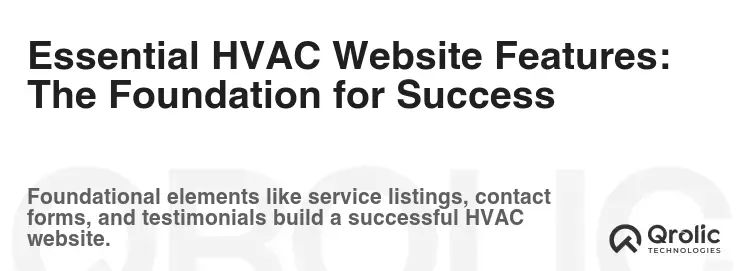
1. A Clean, Professional, and Mobile-Responsive Design
- Why it matters: First impressions are crucial. A cluttered, outdated, or non-responsive website screams “unprofessional” and drives potential customers away. Mobile-responsiveness is non-negotiable, considering that a significant portion of online searches happen on smartphones.
- What to do: Invest in a modern, clean design that reflects your brand’s professionalism. Ensure your website automatically adapts to different screen sizes (desktops, tablets, and smartphones). A positive user experience (UX) is essential. Consider professional website design and branding assistance to solidify your company’s brand image.
- Example: Imagine landing on two websites, one looking like it was built in the early 2000s and the other featuring high-quality images, easy navigation, and a modern layout. Which one would you trust more with your HVAC needs?
2. Clearly Defined HVAC Services Pages
- Why it matters: Users need to quickly find the specific service they’re looking for. Vague or generic service descriptions will frustrate them and send them searching elsewhere.
- What to do: Create dedicated pages for each core service, such as:
- Air Conditioning Repair & Installation: Detail the types of AC systems you service (central AC, ductless mini-splits, etc.), common AC problems, and the benefits of new installations.
- Furnace Repair & Installation: Similar to AC services, specify furnace types, common issues, and the advantages of upgrading to a more energy-efficient model.
- Heating System Maintenance: Emphasize the importance of regular maintenance for prolonging the lifespan of heating systems and improving efficiency.
- Duct Cleaning: Explain the benefits of duct cleaning for improving indoor air quality and reducing allergens.
- Indoor Air Quality Solutions: Offer a range of solutions, such as air purifiers, humidifiers, and UV lights, highlighting their impact on health and comfort.
- Commercial HVAC Services: If applicable, dedicate a section to commercial HVAC solutions.
- SEO Optimization: Incorporate relevant keywords into page titles, headings, and content. For example, “Air Conditioning Repair [City, State]” or “Furnace Installation Cost [Neighborhood]”.
- Actionable Tip: Use high-quality images and videos to visually represent your services.
3. Online Service Request Form: Make it Easy to Connect
- Why it matters: This is the most direct way to convert website visitors into leads. Make it as easy as possible for them to initiate contact.
- What to do:
- Placement: Prominently display the service request form on your homepage and service pages.
- Fields: Keep it concise and only ask for essential information (name, contact information, type of service needed, a brief description of the problem).
- Mobile Optimization: Ensure the form is easy to fill out on mobile devices.
- Confirmation: Provide clear confirmation that the request has been received and what to expect next.
- Benefit Highlight: Show how fast you respond to service requests, example: “Get A Quick Response For Service Requests”.
- Example: Instead of a generic “Contact Us” form, use a form labeled “Request HVAC Service” or “Schedule a Repair Appointment.”
4. Online Maintenance Scheduling System
- Why it matters: Streamline the scheduling process for both your business and your customers. This feature is especially crucial for attracting and retaining recurring maintenance clients.
- What to do:
- Integration: Integrate a scheduling tool into your website that allows customers to view available time slots and book appointments directly.
- Automated Reminders: Set up automated email or SMS reminders to reduce no-shows.
- Customization: Allow customers to select specific services or maintenance packages when scheduling.
- Payment Options: Consider integrating online payment options for added convenience.
- Benefit Focus: Focus on the convenience and time-saving aspects of online scheduling.
- Examples of Scheduling Tools: Calendly, Acuity Scheduling, ServiceTitan (for a more comprehensive business management solution).
5. Customer Testimonials and Reviews: Building Trust
- Why it matters: Social proof is incredibly powerful. Positive reviews and testimonials build trust and credibility, influencing potential customers’ decisions.
- What to do:
- Collect Reviews: Actively solicit reviews from satisfied customers through email, follow-up calls, or review platforms like Google My Business, Yelp, and Facebook.
- Display Prominently: Showcase testimonials on your homepage, service pages, and a dedicated testimonials page.
- Authenticity: Use real customer names and, if possible, include photos.
- Video Testimonials: Consider featuring video testimonials for an even greater impact.
- Actionable Tip: Respond to both positive and negative reviews promptly and professionally. Address concerns and demonstrate your commitment to customer satisfaction.
- Benefit Focus: Emphasize the trust and peace of mind that customer reviews provide.
6. Before & After Photos: Showcasing Your Work
- Why it matters: Visual evidence of your expertise and quality of work can be highly persuasive.
- What to do:
- High-Quality Images: Use professional-quality photos that clearly showcase the improvement in system appearance and functionality.
- Context: Provide brief descriptions of the projects and the problems you solved.
- Organization: Categorize photos by service type (e.g., AC installation, furnace repair).
- Permissions: Always obtain permission from customers before using their photos.
- Impact: Demonstrate the concrete benefits of your services, boosting trust and confidence.
7. Informative Blog Content: Establishing Expertise and Improving SEO
- Why it matters: A blog allows you to establish yourself as an authority in the HVAC industry, attract organic traffic through SEO, and engage with your audience.
- What to do:
- Relevant Topics: Write about topics that are relevant to your target audience, such as:
- Energy-saving tips
- Common HVAC problems and solutions
- Indoor air quality advice
- Seasonal maintenance checklists
- The benefits of upgrading to energy-efficient systems
- Explanation of HVAC technologies
- Keyword Research: Use keyword research tools (e.g., Google Keyword Planner, SEMrush) to identify popular search terms related to HVAC.
- SEO Optimization: Optimize blog posts for relevant keywords, including in titles, headings, and content.
- Consistency: Publish new content regularly to keep your website fresh and attract returning visitors.
- Relevant Topics: Write about topics that are relevant to your target audience, such as:
- Benefit Highlight: Focus on the value that your blog provides to readers, such as saving money, improving comfort, and enhancing indoor air quality.
- Example Blog Post Titles: “5 Signs Your Air Conditioner Needs Repair,” “How to Improve Your Indoor Air Quality This Winter,” “The Ultimate Guide to Furnace Maintenance.”
8. FAQ Section: Addressing Common Concerns
- Why it matters: An FAQ section can answer common questions that potential customers may have, saving them time and reducing the number of inquiries you receive.
- What to do:
- Identify Common Questions: Compile a list of frequently asked questions based on customer inquiries, phone calls, and online searches.
- Clear and Concise Answers: Provide clear, concise, and easy-to-understand answers.
- Organization: Group questions by topic (e.g., pricing, services, maintenance).
- SEO Optimization: Incorporate relevant keywords into questions and answers.
- Benefit Highlight: Emphasize the convenience and time-saving benefits of the FAQ section.
9. Pricing Information (Where Appropriate): Transparency Builds Trust
- Why it matters: While not always feasible for complex projects, providing some pricing information (e.g., starting prices for maintenance packages, service call fees) can increase transparency and build trust.
- What to do:
- Clear Disclaimers: Clearly state that prices are estimates and may vary depending on the specific situation.
- Options: Offer different pricing tiers or packages to cater to various budgets and needs.
- Call to Action: Encourage visitors to contact you for a personalized quote.
- Transparency: While not possible to list all prices, being transparent about service call costs shows upfront pricing which builds trust and is very important.
- Actionable Tip: Consider offering a free quote or estimate to entice potential customers to contact you.
- Benefit Focus: Highlight the affordability and value of your services.
10. Geolocation and Service Area Information
- Why it matters: Ensure that visitors know if you service their area. This prevents wasted inquiries and improves user experience.
- What to do:
- Service Area Page: Create a dedicated page listing the cities, towns, and neighborhoods you serve.
- Map Integration: Embed a Google Map showing your service area.
- Location-Specific Content: Tailor content to specific locations (e.g., “HVAC Repair in [City, State]”).
- Contact Information: Display your phone number and address prominently.
- SEO Optimization: Incorporate location-based keywords into your website content.
11. Live Chat: Instant Customer Support
- Why it matters: Live chat provides instant support to website visitors, allowing you to answer their questions and address their concerns in real-time.
- What to do:
- Choose a Reliable Platform: Select a live chat platform that integrates seamlessly with your website.
- Trained Staff: Ensure that your live chat operators are knowledgeable about HVAC services and can provide helpful information.
- Availability: Set up your live chat to be available during business hours or offer 24/7 support if possible.
- Proactive Chat: Consider using proactive chat to initiate conversations with visitors who have been on your website for a certain amount of time.
- Benefit Focus: Emphasize the convenience and speed of live chat support.
12. Emergency Service Information: Addressing Urgent Needs
- Why it matters: HVAC emergencies can happen at any time. Clearly communicate your emergency service availability and response times.
- What to do:
- Dedicated Page: Create a page specifically for emergency HVAC services.
- Contact Information: Prominently display your emergency service phone number.
- Response Time: Clearly state your average response time for emergency calls.
- After-Hours Availability: Specify your after-hours availability and any additional fees that may apply.
- Benefit Highlight: Emphasize the peace of mind that comes with knowing you’re available to handle HVAC emergencies.
13. Energy Efficiency and Rebate Information: Appealing to Eco-Conscious Customers
- Why it matters: Many customers are interested in energy-efficient HVAC systems and available rebates or incentives.
- What to do:
- Energy Efficiency Page: Create a page dedicated to energy efficiency and the benefits of energy-efficient HVAC systems.
- Rebate Information: Provide information about available federal, state, and local rebates and incentives.
- Energy Star Products: Highlight Energy Star certified HVAC products that you offer.
- Savings Calculator: Consider adding an energy savings calculator to show potential cost savings.
- Benefit Highlight: Emphasize the environmental benefits and cost savings of energy-efficient HVAC systems.
14. Secure Socket Layer (SSL) Certificate: Protecting Customer Data
- Why it matters: An SSL certificate encrypts data transmitted between your website and visitors’ browsers, protecting sensitive information such as contact details and payment information.
- What to do:
- Obtain an SSL Certificate: Purchase an SSL certificate from a reputable provider and install it on your website.
- HTTPS: Ensure that your website uses HTTPS instead of HTTP.
- Security Badge: Display a security badge on your website to show visitors that their information is protected.
- Benefit Highlight: Emphasize the security and privacy of customer data.
15. Fast Page Load Speed: A Crucial Ranking Factor
- Why it matters: A slow-loading website can frustrate visitors and negatively impact your search engine rankings.
- What to do:
- Optimize Images: Compress images to reduce file size without sacrificing quality.
- Enable Browser Caching: Enable browser caching to store static files on visitors’ computers.
- Minimize HTTP Requests: Reduce the number of HTTP requests by combining files and using CSS sprites.
- Choose a Fast Hosting Provider: Select a reliable web hosting provider with fast servers.
- Benefit Highlight: Improve user experience and search engine rankings.
Beyond the Basics: Advanced HVAC Website Features
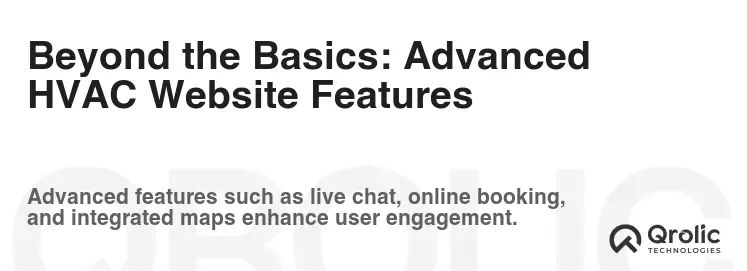
Once you’ve implemented the essential features, consider adding these advanced features to further enhance your website and stand out from the competition:
- HVAC System Diagnosis Tool: An interactive tool that helps users diagnose common HVAC problems.
- 3D Models of HVAC Equipment: Allow users to explore HVAC equipment in 3D.
- Virtual Consultations: Offer virtual consultations with HVAC technicians.
- Integration with Smart Home Devices: Allow users to control their HVAC systems through your website.
- Customer Portal: Provide a secure portal for customers to view their service history, pay bills, and manage their accounts.
- Multi-Language Support: Cater to a diverse customer base by offering your website in multiple languages.
- ADA Compliance: Ensure your website is accessible to people with disabilities.
Qrolic Technologies: Your Partner in HVAC Website Success

At Qrolic Technologies (https://qrolic.com/), we understand the unique challenges and opportunities that HVAC businesses face in the digital world. We offer a comprehensive suite of web design, development, and marketing services tailored specifically to the HVAC industry.
Here’s how Qrolic Technologies can help you:
- Custom Website Design: We create visually appealing, mobile-responsive websites that reflect your brand’s identity and attract potential customers.
- SEO Optimization: We implement proven SEO strategies to help you rank higher in search engine results and drive organic traffic to your website.
- Content Marketing: We develop engaging and informative blog content that establishes you as an authority in the HVAC industry.
- Online Advertising: We manage your online advertising campaigns to generate leads and drive sales.
- Social Media Marketing: We help you build a strong social media presence and engage with your target audience.
- Maintenance Scheduling Software Integration: We can fully integrate maintenance scheduling software, making booking appointments efficient.
Partner with Qrolic Technologies and unlock the full potential of your online presence. Contact us today for a free consultation.
Measuring and Analyzing Website Performance
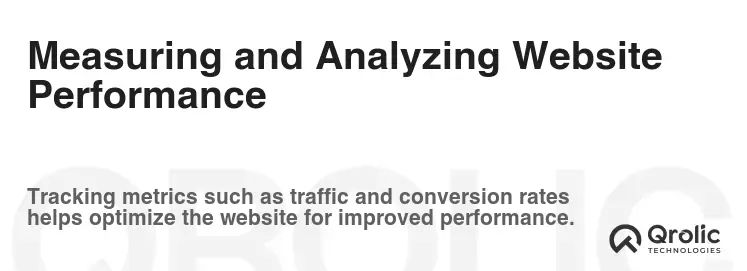
- Why it matters: It’s crucial to know what is working and what is not on your website. Without measurement, improvements are guesswork.
- What to do:
- Google Analytics: Implement Google Analytics to track website traffic, user behavior, and conversions.
- Google Search Console: Use Google Search Console to monitor your website’s search engine performance and identify any technical issues.
- Heatmaps: Use heatmaps to see how users are interacting with your website pages.
- A/B Testing: Conduct A/B tests to optimize website elements and improve conversion rates.
- Regular Reporting: Generate regular reports to track key metrics and identify areas for improvement.
- Key Metrics to Track: Website traffic, bounce rate, time on site, conversion rate, cost per lead, and return on investment (ROI).
Continuous Improvement: The Key to Long-Term Success
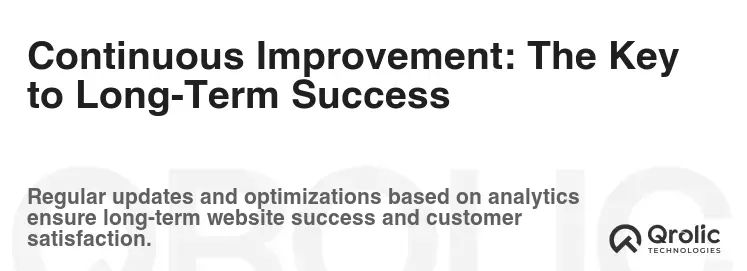
Your website is not a static entity; it’s a dynamic tool that needs to be continuously updated and improved to stay ahead of the competition. Regularly review your website’s performance, gather feedback from customers, and implement changes based on your findings. The digital landscape is constantly evolving, so it’s essential to stay informed about the latest trends and technologies and adapt your website accordingly. By embracing a culture of continuous improvement, you can ensure that your website remains a valuable asset for your HVAC business for years to come.
Conclusion: Investing in Your Online Future

In conclusion, a well-designed and feature-rich website is a critical investment for any HVAC business looking to thrive in today’s digital age. By implementing the key features outlined in this article, you can attract more customers, build trust and credibility, and ultimately grow your business. Remember to prioritize user experience, SEO optimization, and continuous improvement to maximize the impact of your online presence. Partner with a reputable web design and marketing agency like Qrolic Technologies to ensure your website is a powerful tool for success.
By following these guidelines, you can transform your website from a simple online brochure into a lead-generating machine, driving growth and securing your position as a leader in the HVAC industry. Focus on providing value to your visitors, making it easy for them to find what they need, and building trust through transparency and excellent customer service. The results will speak for themselves.
